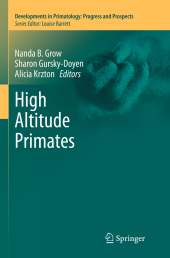 Neuerscheinungen 2016Stand: 2020-02-01 |
Schnellsuche
ISBN/Stichwort/Autor
|
Herderstraße 10
10625 Berlin
Tel.: 030 315 714 16
Fax 030 315 714 14
info@buchspektrum.de |

Nanda B. Grow, Sharon Gursky-Doyen, Alicia Krzton
(Beteiligte)
High Altitude Primates
Herausgegeben von Grow, Nanda B.; Gursky-Doyen, Sharon; Krzton, Alicia
Softcover reprint of the original 1st ed. 2014. 2016. xxi, 360 S. 61 SW-Abb., 46 Tabellen. 235 mm
Verlag/Jahr: SPRINGER, BERLIN; SPRINGER NEW YORK; SPRINGER 2016
ISBN: 1-493-95283-8 (1493952838)
Neue ISBN: 978-1-493-95283-0 (9781493952830)
Preis und Lieferzeit: Bitte klicken
This volume examines how high altitude affects the behavior, ecology, evolution and conservation status of primates, especially in comparison to lowland populations. It gives examples of how geographic scales result in diversification and/or speciation.
The basic goal of the volume is to compile the most up to date research on how high altitude affects the behavior, ecology, evolution and conservation status of primates, especially in comparison to lowland populations. Historically, the majority of primate studies have focused on lowland populations. However, as the lowlands have been disappearing, more and more primatologists have begun studying populations located in higher altitudes. High altitude populations are important not only because of their uniqueness, but also because they highlight the range of primate adaptability and the complex variables that are involved in primate evolution. These populations are good examples of how geographic scales result in diversification and/or speciation. Yet, there have been very few papers addressing how this high altitude environment affects the behavior, ecology, and conservation status of these primates.
High Altitude Prosimian Primates.- 1. Effects of Altitude on the Conservation Biogeography of Lemurs in South East Madagascar.- 2. Hibernation patterns of dwarf lemurs in the high altitude forests of eastern Madagascar.- 3. Altitudinal Distribution and Ranging Patterns of Pygmy Tarsiers ( Tarsius pumilus ).- High Altitude Monkeys.- 4. Biogeography and conservation of Andean primates in Peru.- 5. Population density and ecological traits of high land woolly monkeys at Cueva de los Guacharos National Park, Colombia.- 6. Seed Dispersal by Woolly Monkeys in Cueva de los Guacharos National Park (Colombia): An amazonian primate dispersing montane plants.- 7. Distribution and ecology of the most tropical of the high-elevation montane colobines: the ebony langur on Java.- 8. Snow tolerance of Japanese macaques inhabiting high-latitude mountainous forests of Japan.- 9. Seasonal and altitudinal migration of Japanese macaques in the Northern Japan Alps.- 10. Rhinopithecus bieti at Xiaochangdu, Tibet: Adaptations to a marginal environment.- 11. Nutritional implications of the high-elevation lifestyle of Rhinopithecus bieti .- 12. Variation in primate abundance along an elevational gradient in the Udzungwa.- 13. Deriving Conservation Status for a High Altitude Population: Golden Monkeys of Mgahinga Gorilla National Park, Uganda.- High Altitude Apes.- 14. High Altitude Diets: Implications for the Feeding and Nutritional Ecology of Mountain Gorillas .- 15. Preliminary data on the highland Sumatran orangutans ( Pongo abelii ) of Batang Toru.- 16. Modern Human Biological Adaptations to High-Altitude Environments in the Andean Archaeological Record.-17. High Altitude Primates, Extreme Primates, and Anthropological Primatology (There is More to Human Evolution than Tool Use, Culture, or African Apes).


